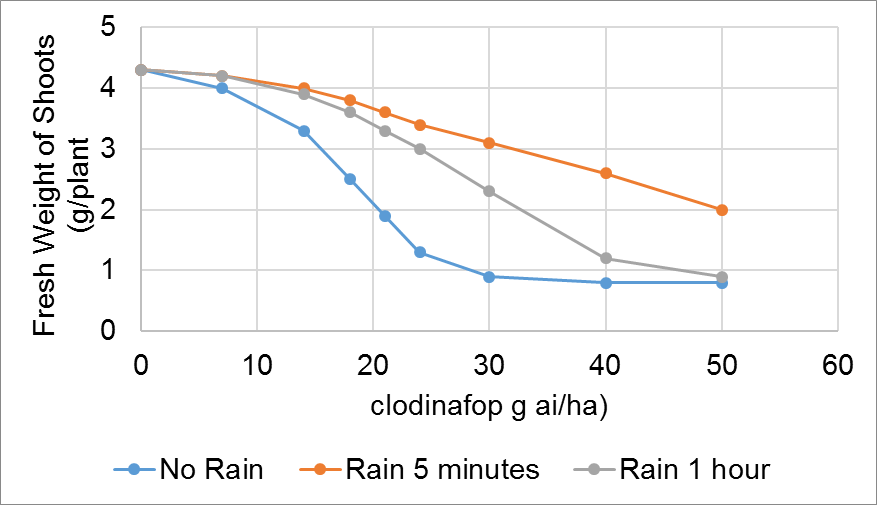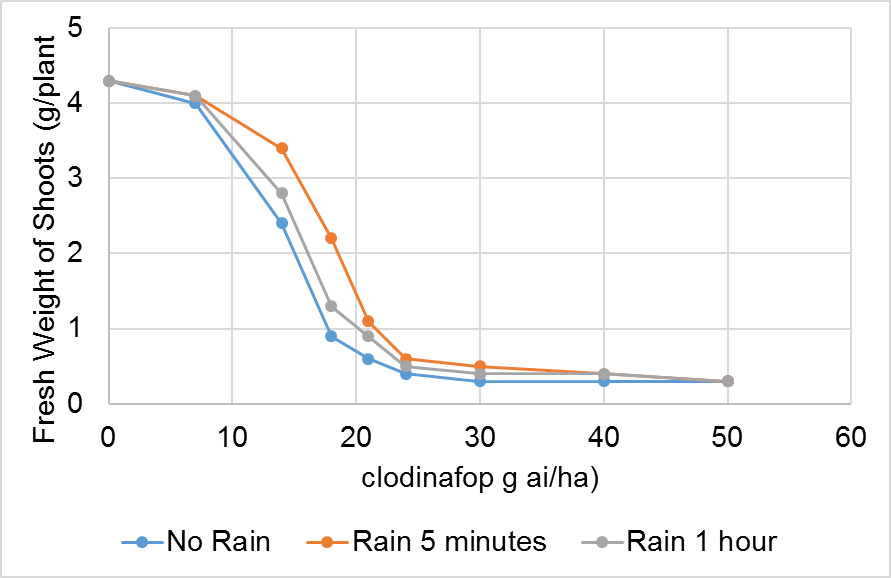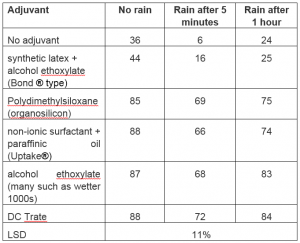Around Australia farmers are currently spraying their winter crops for weeds. Spraying in winter often means battling with rain and wondering whether adjuvants are worth the cost.
In this month’s article, we’ll explore how we dramatically increase the rainfastness of an EC herbicide using an adjuvant.
The trial and error of rainfastness
Most foliar applied agricultural chemicals are designed to either remain on the surface of leaves or penetrate into them, but this does not happen instantaneously, leaving the chemical susceptible to loss by rain. Although most of us understand that particulate products such as suspension concentrates or wettable powders are vulnerable to being washed off the leaf, we are less sure about the vulnerability of solutions and emulsions.

Figure 2. Effect of rain and application rate on the fresh weight of oats sprayed with clodinafop applied without adjuvant.
Given that spraying can cost a farmer hundreds of hours of work, and up to hundreds of thousands of dollars, it’s no surprise that rainfastness is a key criteria for farmers when choosing what chemicals they spray for weeds. Making matters worse, the impact of rain can create doubt in a farmer’s mind as to the effectiveness of specific chemical, making repurchase unlikely and impacting the reputation of the product.
As a result, it’s extremely important that those developing chemicals understand the mechanisms to increase the rainfastness of their products, and can then demonstrate / prove the impact of this improvement.
To this end, we see businesses increasingly utilising adjuvants in their chemicals to enhance the rain-fast performance of their products, as well as to widen the range of conditions for which a given product can be used.
We ran a rainfastness test on a popular EC herbicide with and without adjuvants using our rainfall simulator

Figure 3. Effect of rain and application rate on the fresh weight of oats sprayed with clodinafop applied with adjuvant.
Eureka! has an accurate rainfall simulator which is considerably more accurate than rainfastness tests ever conducted in the field. Droplets from our simulator fall five meters which means that they reach terminal velocity and maximum impact energy before they hit their target. We have studied rainfastness on a lot of products but I will be using the grass herbicide clodinafop as my example in this article.
We sprayed a range of rates of clodinafop EC with or without the adjuvant DC Trate onto oat seedlings. We then applied 5mm of simulated rainfall at an intensity of 56mm/hour after 5 minutes or an hour. Being an EC (emulsifiable concentrate), the active ingredient in this product reaches the leaf dissolved in a droplet of solvent. Is it still vulnerable to rain?
Where the product was applied without adjuvant, it took about 18g ai/ha to reduce the growth of the weed by 50% (ED50). When plants were rained on 5 minutes after spraying the ED50 increased to 45g ai/ha but when rain was applied one hour after spraying it fell back to 30g ai/ha. 64% of the clodinafop was lost when rain occurred 5 minutes after spraying and 40% after an hour (Figure 2)
And found a significant improvement in the chemical’s efficacy and rainfastness

Table 1. Comparison of the reduction (%) of weight of oat plants when sprayed with 17g clodinafop ai/ha and treated with no rain or 5mm of rain 5 minutes or an hour after spraying.
DC Trate had a dramatic effect on the efficacy of clodinafop and on its rainfastness. The first is not surprising as spray oils are mentioned on the label but who knew about the rainfastness? The adjuvant increased the efficacy by 28% but this time only 18% was lost when rain occurred 5 minutes after spraying and 13% after an hour (Figure 3). The adjuvant had increased the efficacy AND the rainfastness.
A similar experiment was undertaken where the effect of DC Trate on clodinafop was compared with other adjuvants; synthetic latex + alcohol ethoxylate (such as Bond ®), polydimethylsiloxane (organosilicon), non-ionic surfactant + paraffinic oil (Uptake®) and alcohol ethoxylate (such as a wetter 1000). In this experiment we measured how much each treatment reduced the weight of treated oat plants (Table 1).
In the absence of rain, the polydimethylsiloxane, non-ionic surfactant + paraffinic oil and alcohol ethoxylate were all as effective as DC Trate as an adjuvant. The synthetic latex + alcohol ethoxylate was inferior. When rain occurred after just 5 minutes all treatments lost efficacy but again only the synthetic latex + alcohol ethoxylate was inferior to the other adjuvants. When the rain was delayed for an hour only the DC Trate and the alcohol ethoxylate were not significantly inferior to the same treatment with no rain (i.e. only these two adjuvants made the clodinafop rainfast within an hour).
At Eureka! we have a lot experience with rainfastness. We have the best rainfall simulator and I have personally been running or managing rainfastness experiments for more than 20 years.
In fact, we’ve run vast numbers of similar tests for customers in the past, giving them demonstrable proof of the increased efficacy and rainfastness of the new products we developed for them or advantages of their adjuvants. They in turn used these result to significantly boost sales based on this point of differentiation.
If you would like to hear more about the capabilities of our rainfall simulator and how we can help you increase the rainfastness of your herbicides, please contact the friendly Eureka! AG Research HERE, and ask for me.
Written By: Anthony Flynn
© 2016 Eureka! AgResearch Pty Ltd
